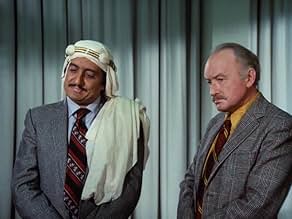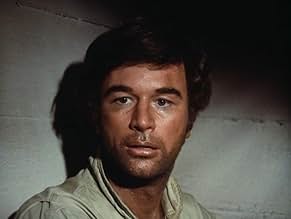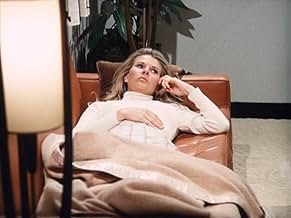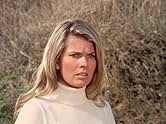IMDb RATING
6.9/10
5.4K
YOUR RATING
After an astronaut and test pilot is catastrophically mutilated in a test plane crash, he is rebuilt and equipped with nuclear powered bionic limbs and implants.After an astronaut and test pilot is catastrophically mutilated in a test plane crash, he is rebuilt and equipped with nuclear powered bionic limbs and implants.After an astronaut and test pilot is catastrophically mutilated in a test plane crash, he is rebuilt and equipped with nuclear powered bionic limbs and implants.
- Awards
- 1 nomination total
Charles Robinson
- Prisoner
- (as Charles Knox Robinson)
George D. Wallace
- General
- (as George Wallace)
Olan Soule
- Saltillo
- (as Olan Soulé)
Claire Brennen
- OSI Committee Member
- (uncredited)
Eddie Garrett
- Security Guard outside Steve's room
- (uncredited)
Featured reviews
A very well done adaptation of Caidin's fine book, it has some interesting differences from the later show. Oscar Goldman, as played by Darrin McGavin is way more heartless and is intent on getting the governments worth out of Steve. Steve is much more mentally distressed and early on, suicidal after being maimed. It played more for adults, with an espionage theme (as did the second 90 minutes installment, Wine Women and War, with perenial bad guy Eric Braeden). It's very close to the book, but eliminates the female Israeli assigned to help Steve. It's very watchable even today and I wouldn't be surprised to see a big budget version get made.
This is the first pilot of a five seasons series. The overall production values are satisfying enough to make the audience believe of that technological advancement miracle possible. This film is dry, raw, authentic, realistic, semi-documentary, existential and even depressing compared to the optimistic patriotic series thanks to the three actors' performance: Lee Majors, Martin Balsam and Darren McGavin. From the start, the character of Austin is defined: a rebel, a maverick, a dreamer, an individualistic test pilot who is a devotee of his past journey on the moon and doesn't follow the rules by the book -- he is late at his official appointment and replies sarcastically to a commanding officer -- Wells comments his attitude in this term: "Steve, you have a positive genius for antagonizing the wrong people". His best friend is, of course, Dr. Rudy Wells, a humanist, an innovator scientist-surgeon whose main concern is Austin's will to cope with his disability -- the name Wells may be a reference to utopist sci-fi writer H.G. Wells. The first waking up of Austin in Colorado's Research Center as an one-eyed, one-armed legless man, who tries to commit suicide during the night, is shocking, morbid and nightmarish -- it reminds me the bleakness of Dalton Trumbo's "Johnny Got his Gun". Austin is a self-conscious pragmatic man who wants to know the prize of his recovery: ruthless vulture ("I am not concerned by feelings"), cynical ("Accidents happen all the time. We just start from scrap"), mean ("Actually, we would prefer a robot -- 'robot' means a slave-worker in Czech --. A robot has no emotional need and responses. You're the optimun compromised"), crippled -- notice that he is also slightly disabled and walks with a stick -- O.S.O. head (scientifical department chief of the C.I.A.) Oliver Spencer sends him to his own death in the desert of Arabia on a suicidal mission where he receives another near fatal treatment. Spencer even asks Wells if he can let Austin in an indefinite artificial sleep until he needs him again. Austin refuses to be manipulated like a guinea pig, a "raw material" and reacts harshly: he slaps Spencer, turns down the hand of female Official Mrs. McKay and tells Spencer a curse before his forced electro sleep. The music of Gil Mellé is outstanding by creating the mood of technology, war and the character's psyche -- Austin is horrified by the view of his future artificial limbs, calls his friend Wells "Dr. Frankenstein, I presume?" after the bionic operation, he is uncomfortable with the ambiguity of the nurse's love impulse and feels monstrous owing to the woman's frightened behavior ("What are you?") after the rescue of her jeopardized son. The blend of experimental, distorted, atonal electronic style and a 1970's jazz helps the pace. Everything you want to know about Steve Austin lies in this rough pilot. Many episodes of the following series uses footages from that one and especially designer Jack Cole's main title. This is the work of Richard Irving who manages to produce and direct a clever adaptation of Martin Caidin's book. The film has an anti-government slant of that era via the Austin and Wells characters -- Austin's feeling about Spencer ("You're more of a robot than I am now") and Wells figure it out about Spencer's working plan for Austin in the Service: "Espionage, sabotage, assassination!" -- and, above all, the moral dilemma that is asked by the author of such advancement in the hands of the Power. There are subsequent themes tackled throughout the leading character: the loneliness and desperation, the inability to communicate, the fear of being abnormal and an outcast forever.
The TV movie that led to "The Six Million Dollar Man" becoming one of the biggest hits of the 1970s, and being fondly remembered by many who were the right age at the time (not least me - I still remember playing with my Steve Austin doll), is strikingly different from what would come. Admittedly the series was hardly a laugh riot, but the source was even straighter, with nothing to indicate that Col. Austin would eventually acquire a bionic girlfriend (and dog) and meet the likes of Bigfoot, a double, and alien killer machines. (We won't mention that "Sweet Jaime" song.)
Not only does Henri Simoun's teleplay furnish our hero with some actual doubt over how much of a human being he is now, but the relationship between him and his superior officer is less chummy - no benevolent Oscar Goldman of the OSI here, instead the OSO's colder Spencer (Darren McGavin, easily taking the acting honours). Plus, when Steve is eventually sent into the field, it's surprisingly straightforward - the movie emphasises drama over derring-do (note the lack of DANANANANANANA sound effects). This isn't always for the best; the actual crash isn't as effective as it could have been, and 30 years on some elements have dated somewhat - who'd be so casual about a nuclear-powered motor today? - but if ultimately it's not as much fun as the series, it's also a bit more thoughtful.
Footnotes: This movie was edited into two parts and shown on the series as "The Moon And The Desert." More importantly, no one here calls him "a man barely alive," let alone says "We can rebuild him" or "We have the technology."
Not only does Henri Simoun's teleplay furnish our hero with some actual doubt over how much of a human being he is now, but the relationship between him and his superior officer is less chummy - no benevolent Oscar Goldman of the OSI here, instead the OSO's colder Spencer (Darren McGavin, easily taking the acting honours). Plus, when Steve is eventually sent into the field, it's surprisingly straightforward - the movie emphasises drama over derring-do (note the lack of DANANANANANANA sound effects). This isn't always for the best; the actual crash isn't as effective as it could have been, and 30 years on some elements have dated somewhat - who'd be so casual about a nuclear-powered motor today? - but if ultimately it's not as much fun as the series, it's also a bit more thoughtful.
Footnotes: This movie was edited into two parts and shown on the series as "The Moon And The Desert." More importantly, no one here calls him "a man barely alive," let alone says "We can rebuild him" or "We have the technology."
This was truly a great series to watch growing up. Who wouldn't want super strength and super speed? I remember in the movie or maybe it was one of the early shows where there was a guy in a rural area (farm maybe?) who looks out over a flat field and sees a man tearing up the road. In the early days, Steve ran pretty fast, as opposed to the slow motion used later.
The movie was set up very well. A man has an internal battle going on when he loses both his legs, his right arm and his left eye. He didn't want to become a machine. Then, later as he is getting used to the idea of being "bionic," he sees an accident and goes to rescue a little girl who is trapped inside. As he rips the door off, and reaches for the pinned girl, something in the car tears a part of his arm. After rescuing the girl, the mother see the arm and screams. So much for being the hero. I wished they would have kept that conflict going a little while longer. Not overplay it...Just keep it going. But, they weren't sure the show would be picked up, so they resolved the conflict...
The movie was set up very well. A man has an internal battle going on when he loses both his legs, his right arm and his left eye. He didn't want to become a machine. Then, later as he is getting used to the idea of being "bionic," he sees an accident and goes to rescue a little girl who is trapped inside. As he rips the door off, and reaches for the pinned girl, something in the car tears a part of his arm. After rescuing the girl, the mother see the arm and screams. So much for being the hero. I wished they would have kept that conflict going a little while longer. Not overplay it...Just keep it going. But, they weren't sure the show would be picked up, so they resolved the conflict...
First TV movie pilot that introduced Lee Majors as Steve Austin, a former astronaut who had walked on the moon, but now is test piloting an experimental aircraft that unfortunately crashes, badly injuring Steve near death, but with the skill of brilliant surgeon Dr. Rudy Wells(played by Martin Balsam) and funding by secretive government representative Oliver Spencer(played by Darren McGavin) rebuild Austin with bionic limbs and sight, increasing his strength and survivability immensely, making him an ideal government operative, if he can only emotionally adjust to his new condition... Good setup to the eventual series has a smart, thoughtful script and good direction by Richard Irving. Pity this realistic style wasn't continued though...
Did you know
- TriviaDuring the opening sequence of the show, the crash shown is actual footage of a crash of the M2-F2 experimental lifting body that was part of the research that eventually led to the development of the space shuttle.
- GoofsThe "Factual Error" that Austin's human left arm should have been amputated to prevent incompatible balance produces an enormous character error if such had occurred. The friendship that is demonstrated between Austin and Dr. Wells would never allow the latter to amputate a healthy arm of his friend, whether it would be mechanically efficient or not. Further, Dr. Wells is portrayed as the kind of man not to violate his Hippocratic oath of "Do no harm" which such an amputation would be in contrast to.
- Quotes
Steve Austin: Yes sir?
General: Have you any idea what time it is?
Steve Austin: [looks up at the sky] About five to seven?
- Alternate versionsRe-edited into two episodes of "The Six Million Dollar Man" for syndication. To pad out the story, scenes were added from The Bionic Woman (1975), The Bionic Boy (1976) and Dark Side of the Moon: Part 1 (1977).
- ConnectionsEdited from Vol perdu (1970)
Details
- Release date
- Country of origin
- Language
- Also known as
- The Six Million Dollar Man
- Filming locations
- Production company
- See more company credits at IMDbPro
- Runtime
- 1h 15m(75 min)
- Sound mix
- Aspect ratio
- 1.33 : 1
Contribute to this page
Suggest an edit or add missing content
































